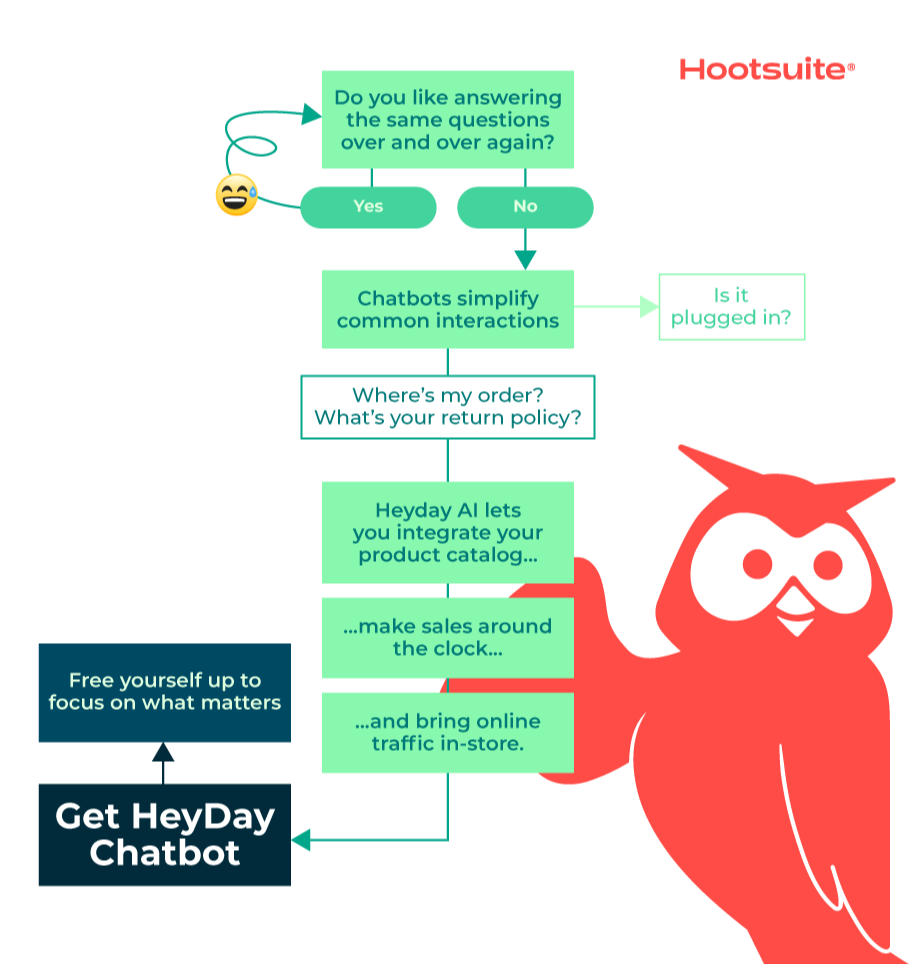The Future of Social Customer Service
A shift to digital during the pandemic left customers more willing than ever to engage with brands over social and messaging channels. But it’s also left them increasingly impatient, inclined to prioritize convenience over price, and ready to walk away from businesses that aren’t meeting their expectations. In 2023, we'll see leading organizations turn to automation to solve their most urgent customer service challenges—and turn a critical eye on who exactly is expected to manage customer service within an organization.


Here’s what you can expect from the year ahead...
A rapid return to in-person shopping makes businesses lose focus on digital customer service
As many marketers struggle to take a greater role in customer service, great ones stand out
- The great reopening blows a hole in digital service
A rapid return to in-person shopping makes businesses lose focus on digital customer service
- Marketers realize it’s time to lean into customer service
As many marketers struggle to take a greater role in customer service, great ones stand out
Customer Service Trend 1
The great reopening blows a hole in digital service
A rapid return to in-person shopping makes businesses lose focus on digital customer service

Shoppers think the quality of customer service has dropped massively
During pandemic restrictions and lockdowns, many companies successfully managed to navigate people’s increased need for digital shopping and services. Ecommerce, curbside pickup, and other online services boomed—and the businesses that successfully revamped their customer experience during the pandemic excelled into 2021.
But as restrictions lifted and shoppers return to brick-and-mortar stores, many businesses have failed to maintain the quality of their digital services in 2022. The overall quality of customer experience fell for more than 19% of brands, Forrester found in a survey of over 96,000 US consumers. Meanwhile, overall customer satisfaction has dropped to its lowest level in 17 years —since the inception of Forrester’s Customer Experience Index.
With the return of in-person shopping, brands have stopped focusing on digital services
Why are consumers unhappy? They’re feeling neglected. During the pandemic, they became accustomed to shopping online—and while many have returned to in-person shopping, they still expect digital services to be available to them.
Businesses can’t just go back to old ways of working and expect their customers to follow suit. In 2023, businesses of all sizes will have to strike a better balance between online and offline customer experience to keep customers satisfied.
Resource-strapped businesses turn to automation
That’s tough news for many business owners who—after fighting tooth and nail to survive a pandemic—now face a confluence of supply chain challenges and declining sales as consumers rein in their spending.
For businesses looking to keep costs in check while boosting the efficiency of online services, cost-effective automation tools will be key in 2023. And customer service should be the highest priority place to go about implementing automation.
Chatbots and simple conversational AI tools can cut down support queues without raising headcount. They allow you to instantly handle frequently asked questions and fulfill online orders. In 2023, these AI tools will become indispensable for businesses struggling to balance online and offline customer service.
Chatbot adopters poised to gain a massive first mover advantage
Even among organizations that prioritize social customer service, conversational AI is still in its early stages. In our survey, only 26% of organizations that said they use social as a primary customer service channel told us they use chatbots on social and messaging apps. And, of the organizations that do use chatbots on social and messenger apps, more than half of them (53%) adopted chatbots at some point during the pandemic.
Share this nowCopied to Clipboard!
In 2023, the businesses that keep their focus on digital customer service stand to win out against those that don’t. Cost-effective chatbots are a quick win for those looking to better their online customer experience while shoring up expenses and limiting overhead in the short term. Over the long term, they’re a worthwhile investment for any business that wants to get out ahead with an emerging technology that’ll become common over the coming decade.
Share this nowCopied to Clipboard!
Decathlon takes the pressure off their people with a chatbot
As a global sport and fitness retailer with more than 2,000 brick-and-mortar stores worldwide, Decathlon knows the importance of delivering world-class customer service.
In collaboration with Heyday, Decathlon UK developed a digital assistant to support its sales and customer service efforts at scale. Today, the digital assistant handles tens of thousands of customer conversations every month—and it’s a resounding success, with Decathlon’s data from Meta showing that 96% of customers were satisfied with their bot interactions.
“We wanted to find a way to reduce our cost to serve, while also engaging new customers,” said Charles Guth, customer loyalty team leader at Decathlon UK. “Heyday’s comprehensive customer messaging platform and Messenger provided the right mix of top-notch conversational AI and platform features to boost our human team’s efficiency.”
Share this nowCopied to Clipboard!

Recommendations
Most customer service requests are variations of the same few questions. That’s not a recipe for a great conversation—that’s an assembly line that needs to be managed. Chatbots simplify these common interactions that would otherwise suck up a ton of your customer service staff’s time. And conversational AI tools like Heyday go a step further: With the ability to distinguish between multiple choices, make a decision, and gather insights, they free your support team up to spend more time solving the problems that really require a human touch.
Let your chatbot answer questions like “Where’s my order?” and “What’s your return policy?” so your humans don’t have to. Conversational AI tools like Heyday let you integrate your product catalog with chat to help customers easily navigate your online shelves—and allow you to make sales around the clock.
Use your chatbot to bring online traffic in-store. With built-in store locator features, Heyday makes it easy for customers to find the nearest store and make an appointment. According to our internal data, 90% of in-store appointments made by our chatbot lead to a purchase and one in four customers are net-new.

Put it into action
Get started with social customer service with this helpful guide to Facebook Messenger.
Customer Service Trend 2
Marketers realize it’s time to lean into customer service
As many marketers struggle to take a greater role in customer service, great ones stand out

Social customer service is largely the responsibility of the marketing department
Last year, we predicted that marketers would take a greater role in customer service in 2022. And, to their credit—and ours—they have. This year, we asked which teams are responsible for providing customer service on social channels. The answer might surprise you.
Share this nowCopied to Clipboard!
Less than 8% of organizations said their customer service team was exclusively responsible for providing customer service on social and messaging apps. Almost half (49%) of organizations said that social customer service was usually or exclusively the responsibility of the marketing team.

Many marketers don’t feel equipped for customer service
Last year, we predicted that social marketers would embrace this newfound responsibility and take more agency in working with customer service teams.
Unfortunately, what we’ve found is that many marketers don’t feel equipped to take on care. Only 21% feel they do a good job servicing customers on social channels, according to a survey by the CMO Council and IBM. Because of this disconnect, many businesses are leaving customers hanging and revenue on the table, says Chris Campbell, CEO of reputation management software ReviewTrackers.
“I think the biggest thing that's still a missed opportunity for a lot of businesses is just taking the time to respond to your customers,” he says. “Right now we’re just hanging up on them when we’re not responding to their queries.”
What’s the root cause of the problem? Campbell thinks a lack of education and rigid silos are to blame.
“In businesses, we theoretically break out functions to be more efficient,” he says, “But it's really everybody's job to deliver a great customer experience. Marketers are neither trained to respond to customers, nor is there an incentive to if that responsibility sits outside their remit and with another team.”
Share this nowCopied to Clipboard!
Proactive marketers will take the initiative to adapt
We get it: Social was never meant to be a customer service channel. But now it really can’t be ignored. Social media has taken an outsized role in customer service—and businesses, as well as practitioners, are caught dealing with the repercussions.
After all, if marketers see it as their responsibility to build brands, ignoring customer service is detrimental to that goal. A brand isn’t just a logo or a promise; it’s a result. It’s a customer’s gut feeling about a product, service, or company. And it’s every marketer’s responsibility to make sure that gut feeling isn’t soured by unanswered DMs.
Share this nowCopied to Clipboard!


Recommendations
Without formal education and training, social is often siloed off from the rest of the organization or treated as an afterthought used to repost promotional messages. In reality, social should be treated as a core function of any modern organization—and that means looping senior members of your social team into high-level strategy and planning. This will get your social strategy fully aligned with your organization’s goals and objectives, and help your social team see how their work fits into the bigger picture for your organization.
For social media marketers looking to build critical skills specific to social marketing or take the next step in their careers, Hootsuite offers training and certification. Whether your team is full of starry-eyed novices looking to build a foundation in marketing basics or seasoned professionals trying to adapt to the demands of a new workplace, our training is designed to help you succeed.
Put it into action
Save time responding to common questions using these free DM replies.
See what's in store for 2023
Social marketing trends
Creators boom, budgets bust, and marketers wise up to the dangers of cross-posting. What to expect in social marketing in 2023.
Social commerce trends
Social overtakes search engines and marketers work to build trust in social shopping. Here’s what’s ahead for social commerce.
